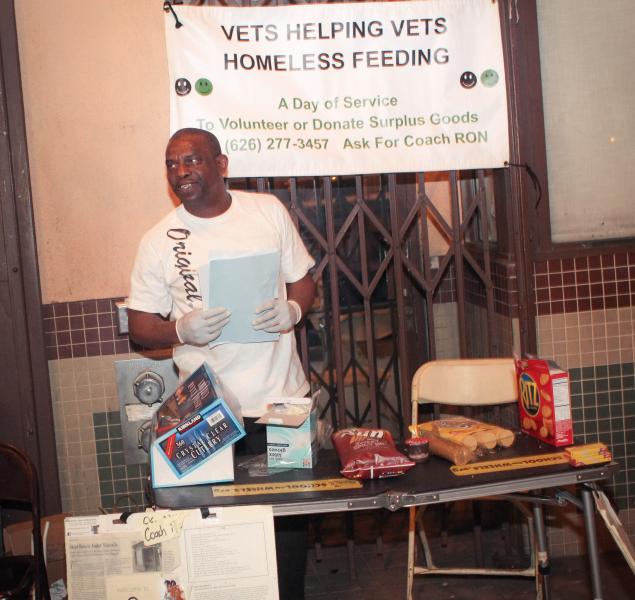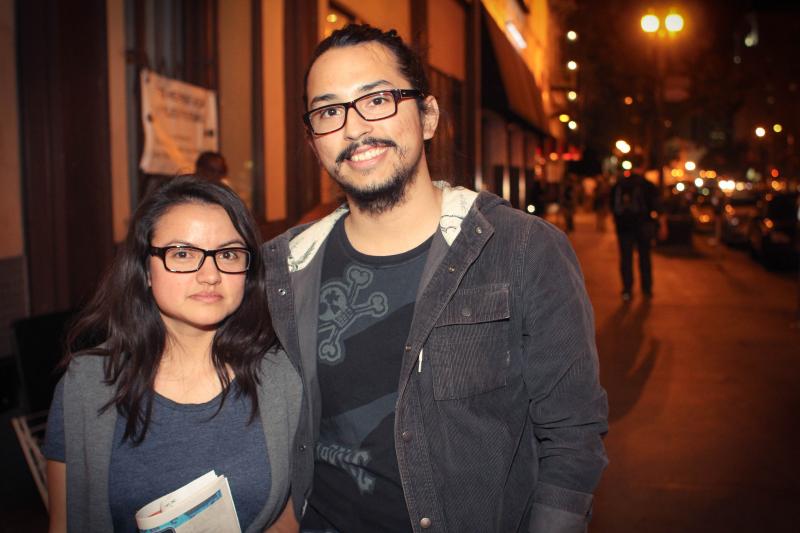Vets Helping Vets On Art Walk

Tonight is the Downtown Art Walk, when locals and visitors come to view art galleries across the city’s Arts District. But not all is about art, especially for two men sitting on the side of the street handing out cookies and crackers for the homeless.
READ MORE: One Arts District To Rule Them All
“This is an outreach effort to bring awareness of the need of the homeless veterans,” said Ron Crockett, a community activist in Downtown Los Angeles. Every month during the Art Walk, Crockett and his friend, Paul Shaw, two formerly homeless men, sit at a black folding table in front of their living complex at the Leonide Hotel, a transitional home for the homeless and low-income individuals. They put out some food and a sign that reads, “Vets Helping Vets.”
Crockett’s father and grandfather served in the army, and Shaw served in the navy. Throughout the evening, they stop people to tell them about homeless veterans. “The average citizen here in world-famous downtown Los Angeles—they are not aware,” Crockett said. “They are unaware, specifically, [of] why most veterans are homeless.”
READ MORE: Plans to Expand The Arts District Might Bring On An Identity Crisis
Travelers who walk by are thankful that these men are increasing awareness about homeless veterans. “I think it’s a noble endeavor,” said Christopher Raya, a resident of Los Angeles and local college student. Raya said he notices a lot of veterans on the streets. Even so, he and his friend, Karen Lopez, said there is a lot they don’t know about.

Shaw now has to wear hearing aids due to severe tinnitus, which is ringing in the ears. The ships would practice war games shooting 18 to 20 foot long tomahawk missiles at targets. “You could be laying in your bed and hear a gun go off and sit straight up,” he said.
Shaw’s life after service is not unusual for many veterans. “When you get out and you come back, I was under the impression that I was going to get some help,” Shaw said. “But they don’t give you help.” When Shaw returned, he went straight to the streets of Los Angeles, where he remained for about 15 years. His life consisted of unemployment, drinking, and drug abuse. He eventually ended up in jail.
But his life took a turn when he got out of jail. “I met a woman, but she had a couple of kids, and I didn’t have nowhere to go. She needed someone to help her, so I helped her raise her children,” he said. The two got married, had kids, and bought a home. For 20 years, Shaw was off the streets raising a family. But at the end of those 20 years, he got a divorce and lost his house. That’s when he then took residence at the Leonide Hotel and met Ron Crockett.
Although Crockett never served in the military, he too lived on the streets. Crockett focuses on veterans because many of his friends are homeless veterans. He hopes his activism will change people’s minds about the homeless. “I want them to say, ‘I’m aware that these people are human. They’re down in luck, but they’re human beings and human beings matter,’” he said.
READ MORE: This Veterans Day, Let’s Stop Screwing Over Veterans
The growing homeless veteran population is being studied at USC’s School of Social Work. Nathan Graeser, who works at the school as a community liaison and analyst, said it’s difficult to properly transition returning soldiers back into the community. Graeser himself has been in the military for 14 years and serves as an army chaplain in the National Guard. “I actually became a chaplain when I lost one of my friends in Afghanistan, and so I realized I wanted to help,” he said.
Graeser has watched many of his friends return home and struggle to reintegrate into society—just like Paul Shaw. When veterans come back, he said, they pick up right where they left off. “You’re essentially like a 19-year-old,” he said. “It’s like starting the process over. You know a lot about life, but not about what civilian sector job you want to do. It’s just a different beast.” Graeser said that employers find it difficult to translate the skills of a veteran into job skills. Graeser is unique in that he does military social work, which has overlap in the civilian sector.
Graeser said when veterans return home, one of their biggest losses is their support network. “If you’ve been deployed for a few years, your family might be close at best. You’ve been gone for a long time,” he said. Although new technology like Skype has helped maintain relationships, he said that what makes people close is shared experience. “When you come back it’s actually like, ‘Oh my gosh. We both changed a lot even though we talked every other day or every week.’”
Fewer than 1 percent of Americans have fought in recent wars, said Graeser, so society struggles to understand veterans. Because not many people are aware of veterans, he said there is little support for them. “What I'm actually asking of the American people is to care—to actually engage in an issue,” he said. “You as a person, if you decide not to serve, then there is a duty on some level to hear at least. If you don't want to serve, then you still need to allow yourself to be affected.”
Contact Staff Reporter Cameron Quon here.



